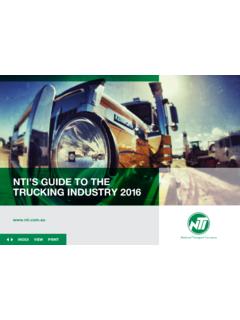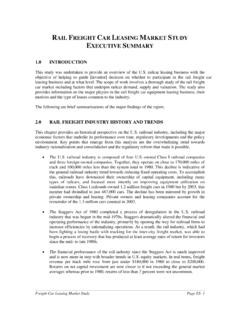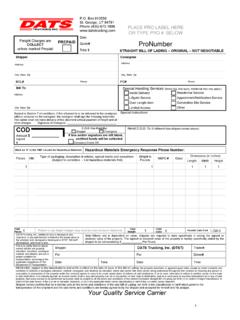Transcription of THE ENVIRONMENTAL EFFECTS OF FREIGHT - …
1 THE ENVIRONMENTAL EFFECTS OF FREIGHTORGANISATION FOR ECONOMIC CO-OPERATION AND DEVELOPMENTP arisDocument complet disponible sur OLIS dans son format d'origineComplete document available on OLIS in its original formatThis paper is part of the OECD work programme on trade and environment. Presented tothe OECD Joint Session of Trade and Environment Experts, it was prepared by Dr. Joy Hecht, aconsultant, under the supervision of Dale Andrew of the Trade Directorate. It is made available onInternet under the responsibility of the Secretary-General of the OECD with the aim of bringinginformation on this subject to the attention of a wider document is also available in for permission to reproduce or translate all or part of this material should beaddressed to:Head of Publications Service, OECD, 2 rue Andr -Pascal, 75775 Paris Cedex 16, FranceCopyright OECD 19973 TABLE OF CONTENTSTHE ENVIRONMENTAL EFFECTS OF FREIGHT .
2 5 Executive 5I. 6A) Defining ENVIRONMENTAL 6B) Quantifying and Comparing Stressors and 6C) Overview of Impacts by ENVIRONMENTAL 7II. Shipping ..11A) Operational Oil Pollution ..11B) Solid Waste Disposal ..12C) Accidental Spills ..13D) Air pollution ..15E) Port and Channel Construction and ) Non-Indigenous Aquatic Air ) Low-altitude Air Pollution ..19B) Global Air ) Airport ) Air Pollution ..21B) Noise ..23V. Rail ..25A) Air pollution ..25B) Noise ..26VI. ) ) Air pollution ..27 VII. Comparisons and Conclusions ..29 REFERENCES ..31 TablesTable 1. Summary of ENVIRONMENTAL Damage by Air Pollution .. 8 Table 2. Major Components of MARPOL 73/78, Annex I (Oil Pollution) ..12 Table 3. Oil Spills into US Navigable Waters, 1992-1994 ..14 Table 4. US Coastal Oil and Chemical Spills per Gallon Shipped ..14 Table 5. Marine Air Pollutant Emission Factors, in grams per 6. US EPA Emission Factors for Marine Vessels in kg/103 litres.
3 164 Table 7. Emissions from Vessels Travelling on Inland 8. Estimated High-Altitude Aircraft Emissions, in grams/ton-km ..20 Table 9. Truck Air Pollution Emission Factors, in grams/tonne-km ..22 Table 10. US EPA Truck Emission Factors for Selected Criteria Pollutants ..22 Table 11. US EPA Particulate and SO2 Emission Factors, in grams/mile ..23 Table 12. Noise Level of Individual Passing Trucks, in dB(A)..23 Table 13. Cost of Truck Noise as a Share of 14. Rail Air Pollution Emissions, in 15. US EPA Railway Air Pollutant Emission Factors in kg/litre of fuel ..26 Table 16. US Pipeline Safety Statistics ..27 Table 17. Pipeline Emissions, in 18. Air Emission Factor Ranges for Truck, Rail, and Marine, in grams/tonne-km ..29 Table 19. Comparison of the average external ENVIRONMENTAL and accident costs of road and railtransport (1991 ECU per 1 000 tonne-km)..305 THE ENVIRONMENTAL EFFECTS OF FREIGHTE xecutive summaryThis review of the ENVIRONMENTAL EFFECTS of FREIGHT is structured by transport mode, addressingshipping, air cargo, trucking, rail, pipelines and intermodal terminals.
4 It begins with a brief overview ofthe major ENVIRONMENTAL media or mechanisms through which transport can affect the environment. Theseinclude air pollution, global climate concerns, noise, water pollution, accidents, land use and habitatfragmentation. The modal discussions focus on air pollution, global climate issues, water pollution,accidents whose costs are ENVIRONMENTAL rather than primarily in human life, and certain land use planningissues. The review describes the impacts in qualitative terms, and then provides emission factors per unitof FREIGHT transported. The most recent estimates of the marginal social cost of some of the impacts areprovided in the comparisons and paper identifies comparable emission factors for only certain kinds of ENVIRONMENTAL harm,notably air pollution and noise. The air pollution data confirm conventional wisdom that trucking is by far themost harmful mode of goods transport.
5 Rail seems to be somewhat more harmful than maritime transport, butthis is not clear-cut; variations in the methods used to estimate the factors may outweigh the differences amongthem. With respect to noise the results are less clear. Conventional wisdom holds that road noise is worse thanrail, but the available data only suggest this, rather than clearly demonstrating it. While airport noise is clearlyan important problem, comparable noise indicators are not available for road or problems involved in quantifying and comparing other ENVIRONMENTAL impacts are alsohighlighted. The pollution caused by ocean FREIGHT , for example, is only indirectly linked to the quantitytransported. Moreover, there is no clear objective basis for comparing air and water pollution. Even moredifficult are ENVIRONMENTAL harms like the introduction of nuisance species or the disposal of contaminateddredged materials, which affect marine ecosystems more than Information and data given in this review describe the situation in the United and States andEurope.
6 However, it should be noted that as the transportation systems in both these continents differsubstantially, comparisons should not be drawn between the two paper provides an overview of the ENVIRONMENTAL impacts of the international transport ofgoods. It was prepared for the Joint Session on Trade and Environment Experts study on trade liberalisation,goods transport and the )Defining ENVIRONMENTAL Impact" ENVIRONMENTAL impact" may be considered to have three components: ENVIRONMENTAL stressors such as pollutants, noise, or exotic species are released in naturalecosystems. Each tonne of goods transported places additional stress on the environment;many stressors may therefore be measured in units per tonne of goods transported; The total amount of stress placed on the environment depends on the quantity of goods andthe distance they are transported; in the simplest form, total stress is the quantity of goodstimes the distance carried multiplied by the stress per tonne.
7 The second component of stressinvolves the spatial pattern of goods transported, including the transport mode used; The ENVIRONMENTAL impact of the total stress is determined by the nature of the receivingenvironment. Ambient characteristics such as physical ecosystem characteristics, density ofthe human population affected, and whether the receiving ecosystem is considered critical orincludes endangered species will determine both the physical impact of the stress andwillingness to pay to prevent paper focuses primarily on the first component of ENVIRONMENTAL impact, with someattention to the )Quantifying and Comparing Stressors and ImpactsSome ENVIRONMENTAL stressors--notably air and water pollutant emissions--are easily quantified,and clearly rise with increases in FREIGHT . Others, such as airport noise or the introduction of exoticspecies, increase with the number of trips made, but not with distance travelled or quantity of goodscarried.
8 Moreover, the ecological harm caused by such stressors may not be quantifiable or directlyrelated to quantity of FREIGHT . This raises the question of how to address stressors which cannot easily beexpressed as emission factors per unit of FREIGHT . Three approaches may be taken to this issue: Limit the analysis to those stressors which can be easily quantified in comparable terms -- These are often considered to be the most harmful ENVIRONMENTAL impacts oftransportation, and limiting the analysis to them may not distort the results significantly; Include all kinds of impacts, but be descriptive when quantification is not possible. Thisacknowledges the importance of all kinds of impacts, but unfortunately can make it easy todisregard those which are not quantified in comparable units; Use valuation techniques which convert all ENVIRONMENTAL impacts to the costs they impose,the costs of avoiding them, or willingness to pay to avoid them.
9 The advantage of thisapproach is clearly that it provides a common unit of analysis with which to compare7different kinds of impacts. The disadvantage is that such valuation is highly subjective andquite difficult to carry paper does not choose among these approaches, but provides information which could belocated to permit any of them. It describes the major ENVIRONMENTAL impacts of FREIGHT in qualitative emission factors per unit of FREIGHT are meaningful and available, it provides them. In some casesestimates have been made of the social costs of ENVIRONMENTAL harms attributable to transportation; theseare given as )Overview of Impacts by ENVIRONMENTAL MediumThis paper is structured by transportation mode. Before beginning that discussion, it is useful toreview the major impacts of transportation by ENVIRONMENTAL medium, in order to discuss theenvironmental impacts of stressors placed by many transportation modes.
10 Subsequent chapters can thenfocus on the quantity of stress placed by each mode, rather than reiterating how it affects the section also briefly discusses several transportation externalities which will not beaddressed further in the paper. These are of several types. Some are too indirect to permit establishmentof a clear link to FREIGHT . For others, data are not available to examine them in detail by mode of transport,so our consideration is limited to a broader discussion of the issue. Finally, some are not considered to fallwithin the concept of "environment" used in this PollutionAir pollution is generally considered to be the most important ENVIRONMENTAL threat posed bytransportation. The table below summarises the major pollutants emitted by moving vehicles, their source,and the harm they can cause to humans, ecosystems, global climate, and property (buildings andmaterials).













